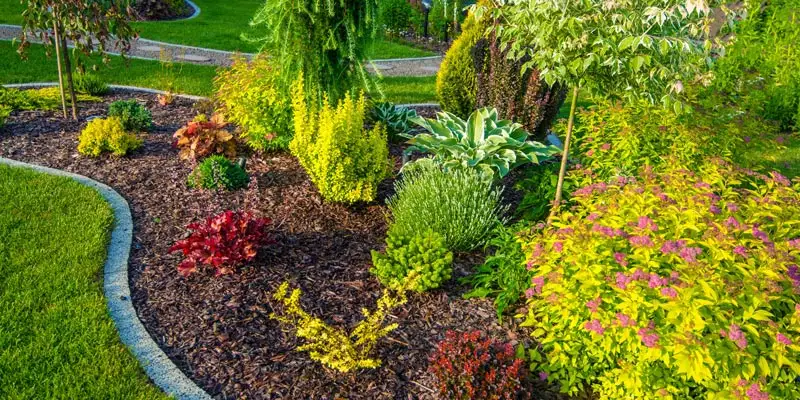Unknown Facts About Landscape Design
Table of ContentsThe 30-Second Trick For Landscape DesignAn Unbiased View of Landscape DesignLandscape Design - An OverviewGet This Report about Landscape Design
A lawn can generally be separated right into 3 locations: public (the front lawn), exclusive (the back lawn), and service (typically the side backyard). The place of task locations depends mainly on the type of location, the dimension of area needed, the type of task, and the desired proximity to other tasks and structures.
The outside wall surface of your home often functions as the very first wall or beginning factor of an outside space. Inappropriate uses should be divided, and associated tasks, such as cooking and eating, ought to be assembled to make the yard a lot more effective and pleasurable. When using hardscape to develop spaces, utilize building and construction product similar to that used in your house for connection from your house into the garden.
Linked areas. Credit Report: Gail Hansen, UF/IFAS Utilizing similar hardscape functions and repeating plants draws the eye around the garden.
From a style point of view, plant products have 3 major features in the landscape: visual, architectural and utilitarian. Visually, plants create an aesthetically enjoyable environment and structurally plants organize and define rooms.
Not known Facts About Landscape Design
For emotional convenience plants are utilized as physical or implied barriers for privacy and security. Physical barriers block both the view and accessibility to an area and consist of fencings, wall surfaces and plant bushes. Landscape Design. Indicated barriers, generally reduced growing plants, obstruct accessibility but not the sight (Figure 9). Other functions of plants consist of cleaning up the air, avoiding disintegration and soil loss, retaining dampness in the soil, and returning natural matter to the soil.
Physical and implied obstacles. Credit: Gail Hansen, UF/IFAS For these factors, the sorts of plants to be used (such as trees, bushes, or groundcovers) must be picked in the early phases of planning. Plant types are selected for their practical abilities to ensure that their future function and required area can be considered at the exact same time.
The overhead aircraft, the upright airplane and the ground plane should all be taken into consideration to develop enclosure. As soon as the form of a plant bed has been developed, the plants need to be massed (organized) and layered to attain visual unity and the wanted amount of enclosure. The dimension of a plant mass will depend on the complete dimension of the lawn, the dimension of the individual plants in the mass, and the focus or impact preferred from the plant product.
Each plant mass remains in front of, behind, or beside, another mass. Figure 11. Straight plant layers. Credit: Gail Hansen, UF/IFAS Number 12. Upright plant layers. Credit Report: Gail Hansen, UF/IFAS Repeating plants within a mass and repeating masses with comparable plants ties the garden together. The specific plant features have to be taken into consideration to efficiently layer and mass plants.
Some Known Incorrect Statements About Landscape Design
All plant compositions begin with the main framework plants, the big, primarily evergreen background plants-such as the trees and huge hedges. These plants different or enframe spaces, manage the dimension of the room, and give the beginning factor for choosing the proper qualities of the 2nd layer, midground plants, for massing and infill.
Important points in the garden need to be highlighted by the usage of special plants, distinctive structures, or garden ornaments. Noting limits or entrances to areas can be done with gateways, arbors, and actions, or through the use discover here of special and vivid plants. The form and/or style theme of the garden will usually help figure out the vital factors and how they should be highlighted.
Other crucial areas in the backyard are focal factors, which useful link is utilized to visually organize a landscaped location. Various point of views or perspectives can expose different make-ups in the landscape that may need a range of focal points.
The Facts About Landscape Design Revealed
Figure 13. Plant kinds. Credit Score: Gail Hansen, UF/IFAS After kind, appearance is the next dominant attribute of a plant; coarse, medium and fine structures can be used for comparison and focus in the landscape. Form and appearance both trump shade in the garden for many of the year. Nevertheless, during specific periods, color will certainly be the most recognizable quality of the yard.


The positive fragrance of plants, the sound of wind in the trees, the noise and appearance of water, and the colors and appearances of sculptures, pots and yard furniture all add to the experience of the garden. One detail that is often neglected is the impact of light on the appearances of the plants.
The entire garden modifications in feature and look over the training course of the day, and the course of a year, as the light and temperature modification from early morning to evening and season to season. Plant selection should consider a plant's growth rate, its mature size and form, and the maintenance it will certainly require.
It is very important to recognize a fantastic read the ultimate fully grown size of plants so they can be put in the right area and spaced properly when they are installed. Giving plants room to expand is a challenge because the common fully grown size is commonly based upon optimum expanding conditions and the environmental conditions of a website might trigger a plant to enlarge or stay smaller.